France, circa 1900. It was the height of the belle epoque, or “beautiful era” — a time when bohemians made art and literature cool, cabaret dancers in can-can skirts teased audiences with their subtle sexuality and dainty ladies with feathered hats and ruffled petticoats sipped tea and nibbled on pastries with their male suitors in Parisian cafes.
So, to name a restaurant after an entire era in French history and then to fail to deliver the slightest resemblance of that country’s cuisine or recreate the atmosphere, was initially a letdown.
Despite its rustic bohemian furnishings like antique clocks, wooden mannequins, sewing machines and other antique collectibles set against red-brick walls, Belle Epoque (美好年代), located close to Zhongxiao Fuxing MRT station (忠孝復興), is more of an American brunch nook with a sprinkling of Italian cuisine mixed with Taiwanese tastes.
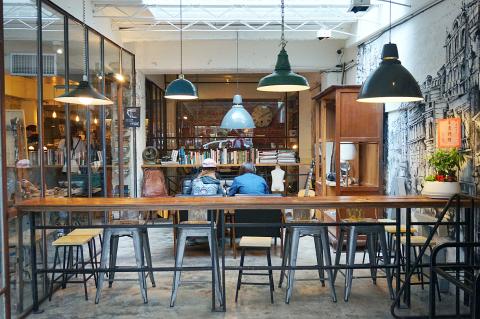
Photo: Dana Ter, Taipei Times
If you can get past the name though, the restaurant is not too bad for what it is — which is a cute place to go on a casual Sunday morning to gossip with friends about the previous night’s escapades over a mountain of hangover fries, rather than a Parisian salon to sip tea while debating the new literary movement.
The selection of drinks at Belle Epoque is quite impressive, albeit pricey. From marshmallow hot cocoas (NT$180) to lychee rose smoothies (NT$220), the names pique your interest by awaking the inner child in you — cocoa with marshmallows on a wintery day? Yes, please.
I decided to go with something I hadn’t tried before: banana hot cocoa (NT$180). Thick, frothy, chocolately and with a dollop of whipped cream on the top, it was at once a little kid’s drink as well as a perfect, sinful Sunday morning treat. You could taste the blended, melted banana inside, which provided a nice counter-balance to the richness of the cocoa. I highly recommend one of Belle Epoque’s whimsical drinks for those seeking an alternative to the usual lattes or cappuccinos.
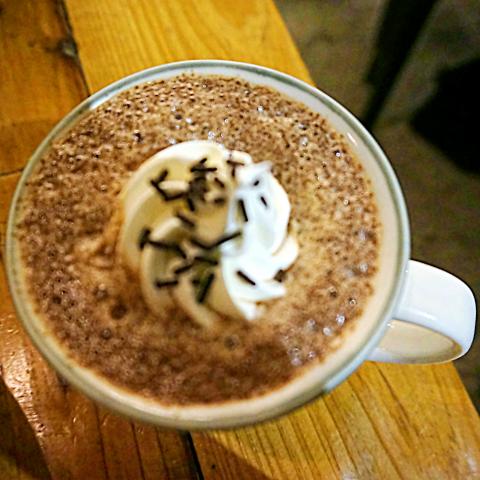
Photo: Dana Ter, Taipei Times
The food department however, was less “bell epoque” and more of the odd fusion of American-Italian-Taiwanese that is common in western-style restaurants in Taiwan. My brunch buddy and I ordered a side of fries with truffle dip (NT$120), expecting the buttery mixture to be poured all over the fries which would be dripping with melted cheese and a good dose of cut shallots.
However, the fries, which looked simply ordinary, came served on a large plate with a small scoop of the dip, which looked and tasted as though it came from a jar on the side. I’ll give it to the chefs that the fries were quite tasty though — encased in a delightful layer of oil and just the right amount of crispy without being burnt. On the other hand, the truffle sauce from the jar tasted less like truffles, and more like tartar sauce.
For the main course, there’s a wide selection of sandwiches, pizza, pasta and burgers. The cajun chicken farfalle (NT$250) came smothered in a light tomato cream sauce, though there was little chicken and practically no cajun flavor. That being said, farfalle, or bowtie, pasta was a fun choice of pasta to use, rather the usual penne or spaghetti. Chopped tomatoes and leeks added a healthy, hearty touch, helping to quell the richness derived from the sauce. The only thing missing was that there could have been more cajun chicken — they seemed more like small flakes of meat interspersed throughout the sauce.
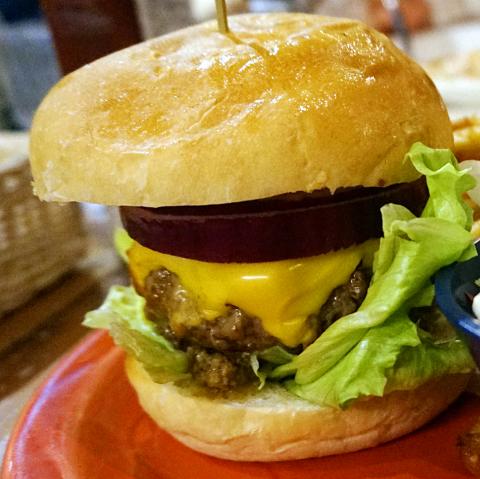
Photo: Dana Ter, Taipei Times
Also worth a mention is the chili con carne burger (NT$250) which I was quite impressed with. The melted cheese, unions of lettuce were pretty standard, so I’ll critique the sauce. I tend to not like my burgers messy, so I was pleased that there wasn’t too much chili sauce. The chili stayed on the soft patty and only dripped to the sides slightly. Although it could have been spicier and the kidney beans a bit bigger, the chili con carne was just enough to entice without overpowering. It was the kind of spicy that gives a kick without a lingering aftertaste.
I would definitely return to Belle Epoque — but next time to sample their Oreo pancakes (NT$250) or pearl milk tea pancakes (NT$230).
Judging by the delectable banana hot cocoa, my hunch is that the restaurant’s strength lies in whimsical drinks and sweet, cavity-inducing desserts, rather than any attempt at fusion.
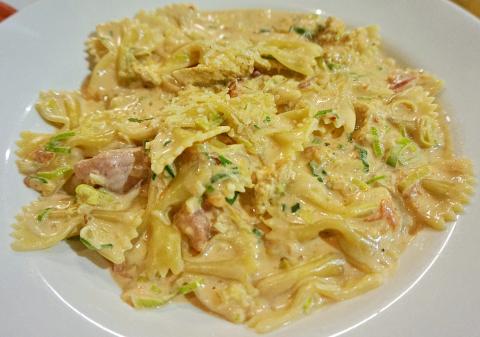
Photo: Dana Ter, Taipei Times
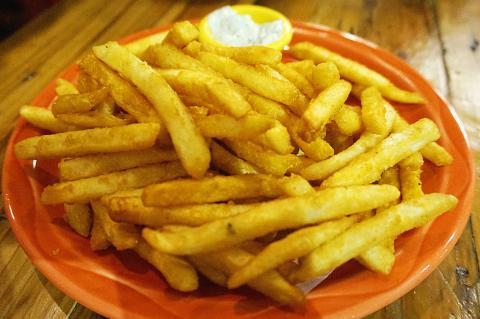
Photo: Dana Ter, Taipei Times

Every now and then, it’s nice to just point somewhere on a map and head out with no plan. In Taiwan, where convenience reigns, food options are plentiful and people are generally friendly and helpful, this type of trip is that much easier to pull off. One day last November, a spur-of-the-moment day hike in the hills of Chiayi County turned into a surprisingly memorable experience that impressed on me once again how fortunate we all are to call this island home. The scenery I walked through that day — a mix of forest and farms reaching up into the clouds

With one week left until election day, the drama is high in the race for the Chinese Nationalist Party (KMT) chair. The race is still potentially wide open between the three frontrunners. The most accurate poll is done by Apollo Survey & Research Co (艾普羅民調公司), which was conducted a week and a half ago with two-thirds of the respondents party members, who are the only ones eligible to vote. For details on the candidates, check the Oct. 4 edition of this column, “A look at the KMT chair candidates” on page 12. The popular frontrunner was 56-year-old Cheng Li-wun (鄭麗文)

“How China Threatens to Force Taiwan Into a Total Blackout” screamed a Wall Street Journal (WSJ) headline last week, yet another of the endless clickbait examples of the energy threat via blockade that doesn’t exist. Since the headline is recycled, I will recycle the rebuttal: once industrial power demand collapses (there’s a blockade so trade is gone, remember?) “a handful of shops and factories could run for months on coal and renewables, as Ko Yun-ling (柯昀伶) and Chao Chia-wei (趙家緯) pointed out in a piece at Taiwan Insight earlier this year.” Sadly, the existence of these facts will not stop the

Oct. 13 to Oct. 19 When ordered to resign from her teaching position in June 1928 due to her husband’s anti-colonial activities, Lin Shih-hao (林氏好) refused to back down. The next day, she still showed up at Tainan Second Preschool, where she was warned that she would be fired if she didn’t comply. Lin continued to ignore the orders and was eventually let go without severance — even losing her pay for that month. Rather than despairing, she found a non-government job and even joined her husband Lu Ping-ting’s (盧丙丁) non-violent resistance and labor rights movements. When the government’s 1931 crackdown